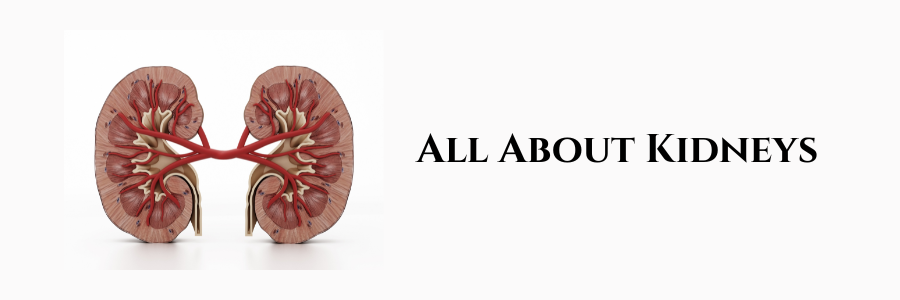Anatomy and Structure
Location: Kidneys are located on either side of the spine, just below the ribcage, in the retroperitoneal space.
Shape and Size: Each kidney is bean-shaped, typically about 10-12 cm.
Components:
- Renal Cortex: The outer layer containing nephrons, the functional units of the kidney.
- Renal Medulla: The inner region with pyramids that transport urine into the calyces. 🔸 Renal Pelvis: A funnel-shaped structure where urine collects before entering the ureter.
- Nephrons: Each kidney has about 1 million nephrons, consisting of:
- Glomerulus: A network of capillaries that filters blood.
- Tubules: Responsible for reabsorption and secretion to form urine.
Functions of the Kidneys
Filtration:
- Filters about 50 gallons (180 liters) of blood daily to remove waste and excess substances.
- Produces urine, which contains water, salts, and metabolic waste (e.g., urea, creatinine).
Regulation of Homeostasis:
- Electrolyte Balance: Regulates levels of sodium, potassium, calcium, and magnesium.
- Acid-Base Balance: Maintains blood pH by excreting hydrogen ions and reabsorbing bicarbonate.
Hormone Production:
- Erythropoietin (EPO): Stimulates red blood cell production in the bone marrow.
- Renin: Regulates blood pressure via the renin-angiotensin-aldosterone system (RAAS).
- Active Vitamin D: Converts calcidiol into calcitriol to regulate calcium and phosphorus metabolism.
Blood Pressure Regulation:
- Controls fluid volume and sodium levels, influencing blood pressure.
Detoxification:
- Removes drugs and toxins from the bloodstream.
Diagnostic Tools
Blood Tests:
- Creatinine: Measures waste product levels to assess kidney function.
- Blood Urea Nitrogen (BUN): Indicates waste accumulation.
- eGFR (Estimated Glomerular Filtration Rate): Evaluates overall kidney function.
Urine Tests:
- Urinalysis: Checks for proteins, blood, or infection.
- 24-Hour Urine Collection: Measures urine output and substance excretion.
Imaging:
- Ultrasound: Visualizes kidney size and structure.
- CT/MRI Scans: Identifies abnormalities like stones or tumors.
- Biopsy: Examines kidney tissue for disease.
Common Kidney Disorders
- Acute Kidney Injury (AKI): A sudden decrease in kidney function, often reversible.
- Chronic Kidney Disease (CKD): A gradual loss of kidney function over time.
- Kidney Stones: Solid mineral and salt deposits forming in the kidney.
- Polycystic Kidney Disease (PKD): A genetic disorder causing cyst formation, impairing kidney function.
- Urinary Tract Infections (UTIs): Often involve the kidneys when untreated, leading to pyelonephritis.
- Glomerulonephritis: Inflammation of the glomeruli, leading to proteinuria and hematuria.
Read also:
Resource Person: Akmal K. Ishak

